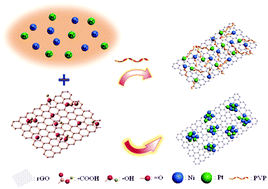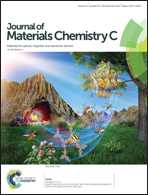Facile control of metal nanoparticles from isolated nanoparticles to aggregated clusters on two-dimensional graphene to form optical limiters
Abstract
The aggregation state of Pt and Ni metal nanoparticles (NPs) can be easily controlled from isolated individual NPs to aggregated clusters on two-dimensional reduced graphene oxide (rGO) by one-step chemical reduction. Formation of Pt–Ni NP/rGO and Pt–Ni cluster/rGO depends on the introduction of poly-(vinyl pyrrolidone). In the Pt–Ni cluster/rGO nanohybrid, Pt NPs are encapsulated by Ni NPs to form Pt–Ni clusters on rGO, which significantly changes the surface chemical state of the Pt NPs. The corresponding nonlinear optical (NLO) and optical limiting (OL) properties were investigated by the open-aperture Z-scan technique with nanosecond pulses at 532 nm. The results show that the Pt–Ni cluster/rGO hybrid has stronger NLO and OL effects than the Pt–Ni NP/rGO hybrid in both liquid and solid matrices. The main contributors to the NLO and OL effects in the Pt–Ni/rGO nanohybrids in both the liquid- and solid-state matrices are a combination of nonlinear absorption and nonlinear scattering, although the mechanism in nonlinear scattering is completely different. Transfer of electrons from Pt to Ni owing to the difference in their electronegativities contributes to the enhanced NLO and OL responses in the Pt–Ni cluster/rGO both in suspension and in a gel glass composite. Thus, the NLO and OL responses of two-dimensional GO can be effectively modified by altering the aggregation state of the metal NPs on its surface. This strategy could be easily extended to tailor the optoelectronic properties of graphene-based composites.



 Please wait while we load your content...
Please wait while we load your content...